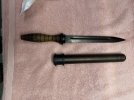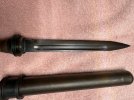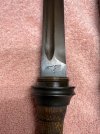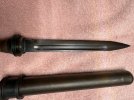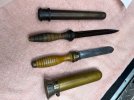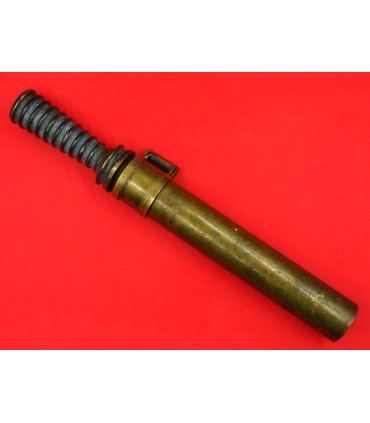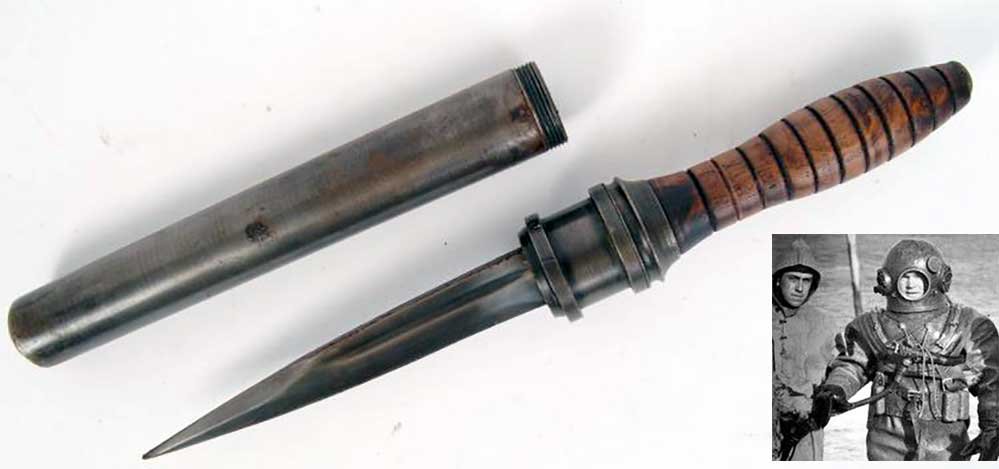I'm not an expert, but consider the following examples of Kriegsmarine dive knives from the third reich:
Regimentals

regimentals.co.uk
Regimentals

regimentals.co.uk
Third Reich militaria offered by longtime collector specializing in Afrika Korps tropical headgear, Panzer, Waffen SS, Luftwaffe, Kriegsmarine, Heer headgear, awards, medals, edged weapons, posters, ....
www.oakleafmilitaria.com
Original Item: One of a Kind. This is an extremely rare example of a German WWII Kriegsmarine (Navy) Diver's Knife, complete with the original brass scabbard. Original WWII examples are almost never seen on the market, as most were lost long ago or melted down for the brass. This example is...

www.ima-usa.com
KM diver's knife by Henckels

militaria39-45.com
It looks like there was some variation in the styles of dive knives from the time, but key features are heavy brass handles and brass scabbards, waffenamt stamps on the scabbard, and a long, broad blade of polished steel with a rounded or chisel-like blade. Apparently many of them were made by J.A. Henckels, but markings are inconsistent and some were made by other manufacturers. None of those features are really present in your example, although the scabbard might be highly tarnished brass with some internal steel component that makes it slightly magnetic, but I couldn't say. Evidently the above models are rare because they were often cannibalized at one time or another for the valuable brass components.
Your knife looks like a blade was taken from a German bayonet and modified to be used as, or at least appear to be, a dive knife. It seems to me like an odd combination of components and materials to be useful for a dive knife. I found several examples like yours but haven't seen much information about them. Note that most of the links below are from old auctions which state that the knives are unauthenticated and sold as-is, so do with that what you will.
GERMAN WW2 KRIEGSMARINE DIVER'S KNIFE, DAGGER WWII Second World War German made divers knife. 1st variant. With turned

www.liveauctioneers.com
WWII German Third Reich diver's knife with makers mark. Dagger features round synthetic material handle, handle base is threaded to fit into threaded scabbard. Blade base is marked "H5662 with makers mark above, Opposite side is marked "RZM" M7 / 72. Length is 15.5 inches. blade length is 8...

live.affiliatedauctions.com
WWII German Third Reich diver's knife with makers mark. Dagger features round synthetic material handle, handle base is threaded to fit into threaded scabbard. Blade base is marked "H5662 with makers mark above, Opposite side is marked "RZM" M7 / 72. Length is 15.5 inches. blade length is 8...

live.affiliatedauctions.com
None of this is to say that yours is not a genuine dive knife from the third reich. I understand that the German war machine used any/all manufacturers and materials at their disposal during the war years and became much less concerned with quality control near the end. It is very well possible that the Kriegsmarine adopted one model/design of dive knife, subcontracted it out to whichever bidder was lowest at the time, then decided later on to "just roll with it" when some whacky knives were cobbled together from available parts when other materials became scarce.
Regardless, it's a very cool piece that, if genuine, appears to be in excellent condition.
